House Sparrow: Field Guide, Pictures, Habitat & Info
Last Updated on
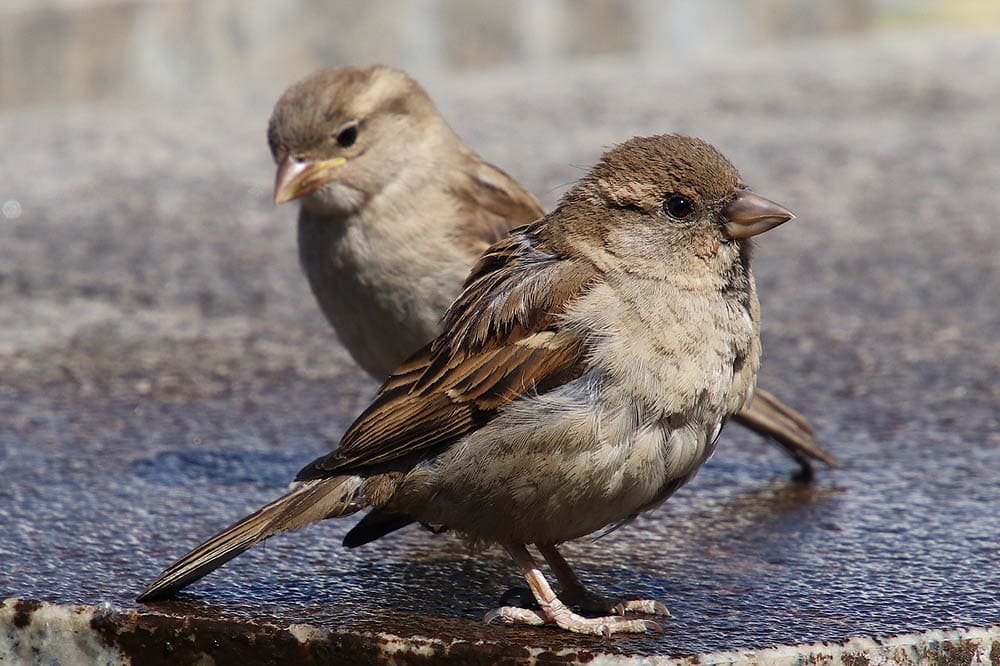
Across the Americas, house sparrows are a common sight among small birds. Although they’re considered a pest for most backyards, these birds have many features that make them a great species for birding enthusiasts that reside in urban areas.
If you want to learn more about house sparrows, read on!

Quick Facts About the House Sparrow
| Habitat | Towns, cities, farms, suburbs |
| Diet | Grains, seeds, insects |
| Behavior | Social, traveling in flocks |
| Nesting | On buildings, other artificial structures, nest boxes |
| Conservation | Low conservation concerns |
| Scientific Name | Passer domesticus |
| Lifespan | 3 years |
House Sparrow General Description
House sparrows are approximately 6 to 6.7 inches long and weigh around 1 ounce, although they do appear to be a little bit chunky. Male sparrows have gray and reddish-brown feathers on their heads with a black bib. Their wings sport the same colors. Their chest and underbelly are gray. Female house sparrows have an all-over coloring of buffy-brown and gray with some brown and buff stripes on their backs.
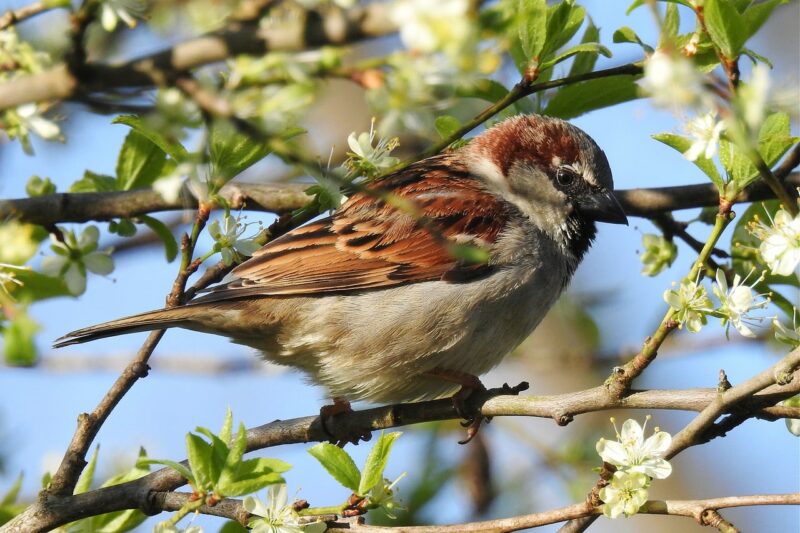
House Sparrow: Range, Habitat, Behavior, Diet & Nesting
Range
House sparrows can be found all over North America. The only places where you will not spot house sparrows are in the far north of Canada and Alaska, most likely due to the colder temperatures during the winter.
Habitat
House sparrows can be found in almost any place where people dwell. From cities to farms, house sparrows are not picky! The reason for this is that these birds look for artificial structures to make their nests in. Old barns, house awnings, and even street lights can be a place for a sparrow to nest. House sparrows are not widely found in dense uninhabited forests.
Behavior
House sparrows are considered slightly noisy birds. They are social and often feed in groups. House sparrows that are used to people will not be intimidated by your presence if food is around.
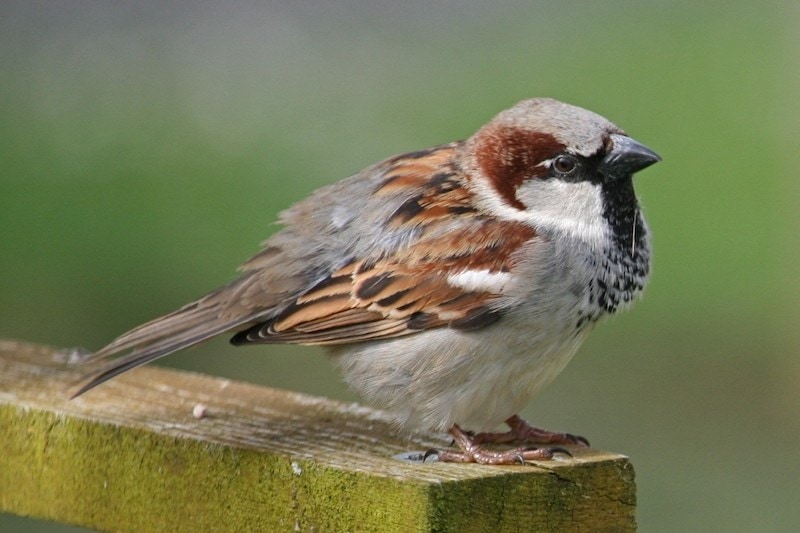
Diet
House sparrows are omnivores; however, they usually feed on seeds, grains, and other wild plants. They will also feed on small insects. House sparrows always appreciate bird feeders full of seeds! But they will pick at discarded people food should the opportunity arise.
Nesting
House sparrows will nest in or on many artificial structures. They will also compete for nest boxes that people put up on their property. They may be small, but they can be tough if need be! House sparrows will usually make their nests out of dried grass and other vegetation. However, if they can find string or other soft materials, they will incorporate that into their nest building.
House sparrows usually lay 1–8 eggs per clutch, with 1–4 broods per year. The spotted light greenish-white eggs are less than an inch long. The incubation period of the eggs is 10–14 days, with a similar range for nestling.

How to Find House Sparrows: Birdwatching Tips
What to Listen For:
House sparrows make a slightly common cheep and chirrup sound, at least to inexperienced birdwatchers. These birds are usually more vocal when courting or competing for food.
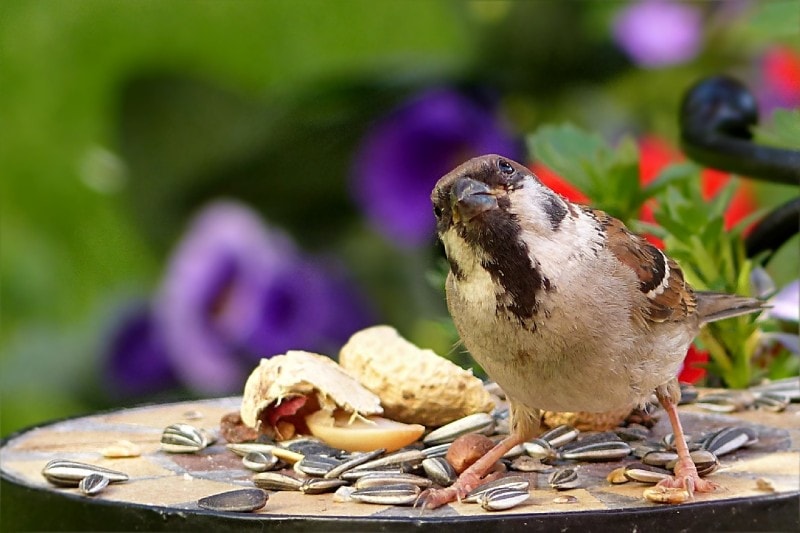
What to Look For:
House sparrows are very common, so look around the eaves of your roof, garages, street lights, and, well, almost anywhere! Putting out some birdseed in a feeder on your balcony, front or backyard, or on your windowsill will attract some house sparrows!
When to Look:
House sparrows can be found all year round. They only migrate medium distances during the winter so depending on where you are in North America, you may still see them often. And, of course, having birdseed available will increase your chances of seeing them during the spring and summer.
Attracting House Sparrows to Your Backyard: Tips & Tricks
If you want to attract some house sparrows to your yard, it is fairly easy! Consider doing the following:
Have birdseed available. The quickest way to a house sparrow’s heart is with food! Stock up on some birdseed, and you will have house sparrows flocking to your home in no time!
Get sparrow-appropriate feeders. While house sparrows are more than happy to peck for food on the ground, having a feeder appropriate for small birds is a good idea! Make sure the feeder has a place for the sparrow to perch and eat.
Set up a bird bath. Sparrows love a quick splash in clean water. If you are feeling creative, you can make a bird bath, or you can buy a lavish one. Just make sure you keep it clean. No bird likes to bathe in or drink dirty water.
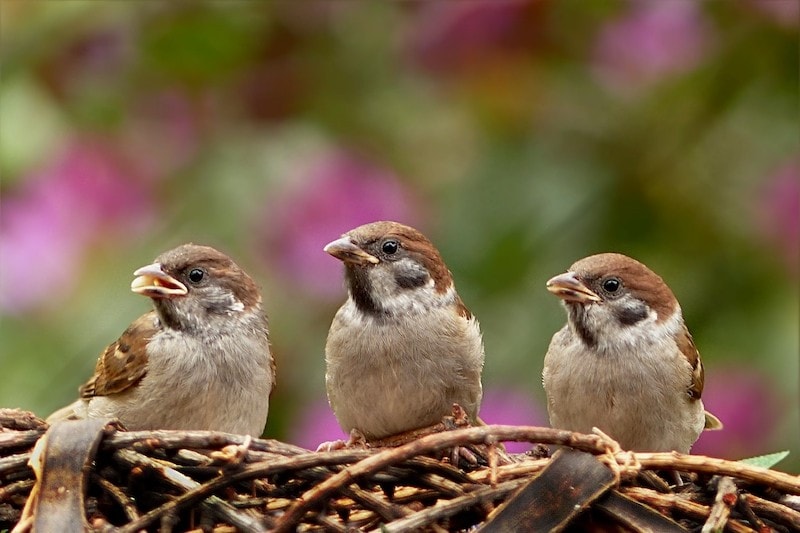
House Sparrow Conservation: Is this Bird Threatened?
No. The house sparrow is not threatened. In fact, some people think that house sparrows are a pest because they will build nests anywhere. Some people do not want these birds nesting in their garages or on their roofs.

Summing Up
While house sparrows are quite common, they are an interesting bird to watch. They are social, easy to find, and quite cute. As long as you do not have any cats, try to attract house sparrows to your yard for observation. Who knows? You might already have some house sparrow nests in your neighborhood!
Featured Image Credit By: betexion, Pixabay
Table of Contents
About the Author Robert Sparks
Robert’s obsession with all things optical started early in life, when his optician father would bring home prototypes for Robert to play with. Nowadays, Robert is dedicated to helping others find the right optics for their needs. His hobbies include astronomy, astrophysics, and model building. Originally from Newark, NJ, he resides in Santa Fe, New Mexico, where the nighttime skies are filled with glittering stars.
Related Articles:
10 Types of Hummingbirds in Arkansas (With Pictures)
8 Types of Hummingbirds in Nebraska (With Pictures)
5 Types of Hummingbirds in Idaho (With Pictures)
3 Types of Hummingbirds in Mississippi (With Pictures)
8 Types of Hummingbirds in Kansas (With Pictures)
5 Types of Hummingbirds in West Virginia (With Pictures)
5 Types of Hummingbirds in Ohio (With Pictures)
Where Do Nuthatches Nest? Nuthatch Nesting Habits Explained
